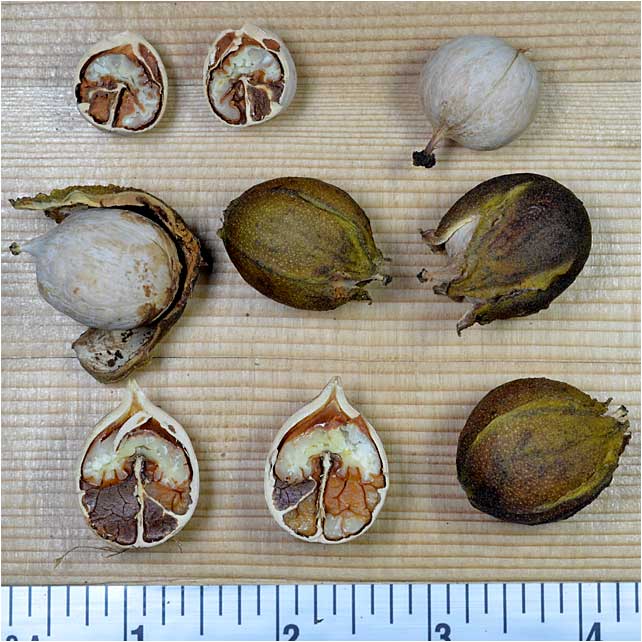36. BITTERNUT HICKORY
Carya cordiformis

The Bitternut Hickory, Carya cordiformis, is one of the 9 species of Hickory trees in the U.S. Four of them are commonly found in CT: Shagbark, Bitternut, Pignut, and Mockernut. There are six hickory trees in this area of the Arboretum called the Hickory Corner. Fall is a particularly showy time for hickories - their fall foliage is dramatic.
FALL, LEAF & FRUIT

Variance in Fall leaf size and shape in Bitternut Hickory. The bitternuts also fall from the tree in Fall, and may be found on the ground in various colors. They will eventually break open on their own, allowing even easier access for wildlife. Bitternut Hickory is a native keystone tree species and extremely important to members of all levels of the ecosystem from insects through mammals.
SPRING, FLOWERS M & F

The male flowers are called catkins (left) and they are very visible on the tree along with the emerging leaves of Spring. The tiny female flowers (right) are very hard to see, even at eye level. You have to search inside the leaf structure and find the area between stems (called a leaf axil). Two weeks and if fertilized, they start to produce the Hickory fruit.
GROWING SEASON

Once fertilized in Spring, the Bitternut Hickory fruit (the nut is inside a husk) develops over the summer months and ripens in fall. They are difficult to see in tall trees, plus they nestle in between the 7-leaflet rachis which make up the Bitternut's leaf.
WINTER

In Winter, the Bitternut Hickory reveals a soaring trunk and towering canopy. These features enable the tree to dominate the upper canopy of a Northeast forest. Indeed, since the last Ice Age, the state of CT has typically been an Oak/Hickory forest. The most populous forest species were also keystone species which supported the largest network of insects, birds, and mammals. As we replant our urban forests today, food for thought. Plant native Hickory, Oak, Red Cedar, and native Black Cherry.
BITTERNUT HICKORY, HUSK & NUT

When ripe, the Bitternut Hickory nut falls from the tree and splits into 4 segments. The thin husk hides the white nut. Half sections of the nut reveal the inside of the nut. It is edible, but quite bitter, but wildlife doesn't seem to care.